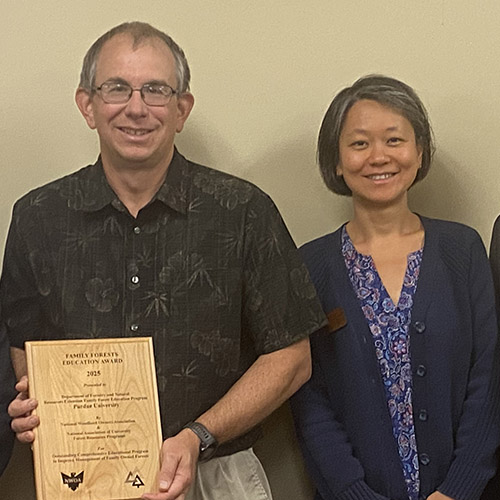Enhancing the Value of Public Spaces Team Honored by PUCESA
The Enhancing the Value of Public Spaces: Creating Healthy Communities Team, has been honored for its efforts by the Purdue Cooperative Extension Specialists' Association (PUCESA).
The collaborative effort of Purdue Extension professionals from Forestry and Natural Resources, Health and Human Sciences, Supplemental Nutrition Assistance Program – Education Division (SNAP-Ed), and Community Development, as well as Illinois-Indiana Sea Grant, earned recognition as a PUCESA Team Award honoree.
The EVPS: CHC campus leadership team consisted of:
- Blake Connolly, assistant director of Purdue Extension, Nutrition Education program
- Lisa Graves, assistant program leader, Purdue Extension, Health, and Human Sciences
- Kara Salazar, Assistant Program Leader and Extension Specialist for Sustainable Communities, Purdue Extension, Illinois-Indiana Sea Grant and Purdue FNR
- Daniel Walker, Community Planning Extension Specialist, Purdue Extension, Illinois-Indiana Sea Grant
- Michael Wilcox Jr., assistant director, and program leader, Purdue Extension, Community Development
The Enhancing the Value of Public Spaces program provides Extension professionals with the information, tools, processes, and research base needed for them to guide decision-makers and local leaders with oversight and management of community public spaces and public health. The program aims to help participating communities recognize public spaces as community assets; understand the significant influence of the built environment on the health of people and places in their community; develop and implement change strategies and indicators to support the process of creating Healthy Eating and Active Living environments; and to integrate public spaces into communities' planning and development activities to contribute to the process of creating a healthy, thriving and sustainable community.
Program implementation may involve parks board and planning commission members, public officials and their staff, and members of organizations involved with programming or management of public spaces. Health coalitions and other organizations working in the realm of active living and healthy eating also play a key role.
The CHC program consists of a series of scoping sessions and community workshops over the course of three to six months. Using an overlay of the community capitals framework and change strategies as a guide, community stakeholders are led through an Appreciative Inquiry process to identify and build on current public space assets, enhance existing community plans, inform future efforts and develop contest-specific strategies to create and sustain healthy, thriving communities.
The program has reached over 460 participants and contributed more than 850 volunteer hours in developing action plans that are used for parks and recreation master plan updates, comprehensive plan updates and downtown redevelopment. Seven community groups have completed the process of developing a high-quality action plan, while an eighth is currently participating in the program.
One example of successful implementation is the city of Connersville, Indiana, where representatives worked with the CHC team to develop an action plan focusing on integrating health and wellness into several community initiatives. The efforts became part of the city's comprehensive plan update and the Mayor authorized $100,000 for the purchase of land in the downtown corridor to create a community garden.
"Working with the Purdue team, we convened several public meetings inviting many diverse groups to come together to assess what was really needed in downtown Connersville – not just what a small segment of us "thought" was needed," Carolyn Bunzendahl, vice president of Discover Connersville, said. "The team helped coalesce these assorted agencies and individuals into a dynamic collaborative having the goal of revitalizing our downtown. It was a very beneficial experience for us to participate in the EVPS: CHC program."
The CHC team also worked with the Putnam County Parks Board to create a five-year county parks master plan.
"The Purdue name, the team's experience, the local Purdue Extension connection, and the dedication and motivation each of them showed, engaged more than 800 residents and will result in Putnam County's ability to be at the Indiana Department of Natural Resources grant funding table in 2022," Eric Freeman, tourism director of the Putnam County Convention and Visitors Bureau, said. "The Putnam County Parks Board, Putnam Parks and Pathways, Friends of the Park of Putnam County, and the Putnam County Convention and Visitors Bureau – the local team, coordinating with the local Purdue Extension office – owes the on-campus EVPS: CHC team a lot. We are headed for success because of their willingness to do an incredible amount of extremely detailed work in a very short timeframe."
The multidisciplinary collaboration extended beyond Purdue University and Extension as colleagues from the University of Kentucky Extension, the University of Illinois Extension and Ohio State University Extension contributed to the program in the form of peer-reviewed publications and resources. An advisory board of diverse representatives from various organizations throughout Indiana also provided instrumental feedback into the development of the program. The CHC team also works alongside local Extension leads to guide and facilitate program efforts in each community.
The CHC program has great potential for replication as the leadership team has developed a model for field staff training as a sustainable state-wide model of program management and delivery. Additionally, the leadership team has created a modest cost-recovery model for the program, which provides funds for training future staff and covering expenses for staff delivering the program. The process and training efforts have been shared through national presentations such as the Society for Nutrition Education and Behavior, the National Association of Community Development Extension Professionals, and the National Health Outreach Conference.
Story by Wendy Mayer, Communications Coordinator






